Having read La Gazzetta Dello Sport last week, time to review how most Italians follow the Giro: on TV via the national broadcaster RAI. As well as the live race coverage there’s plenty more in and around the race to watch. What it’s like to spend a day watching this?
RAI? It’s the Radiotelevisione italiana, the state broadcaster and part of Italy’s finance ministry. RAI is pronounced “rye” as in bread. The broadcaster has several channels including free-to-air sports channels Rai Sport 1 and Rai Sport 2 which carry most of the cycling but the Giro is big enough to cross over to main channel Rai 3.
Rai Sport 2 has a cycling magazine show all year called Radiocorsa (“Race radio”) which covers plenty, even the U23 scene and it’s the only regular magazine show on TV in Europe dedicated to cycling, even cycle-crazy Flanders doesn’t get this (in part because cycling makes the mainstream sports broadcast there). Back to the Giro and there’s a lot more coverage every day than viewers accustomed to the international feed on Eurosport or BeIn get…
The day’s coverage begins with the Viaggio nell’Italia del Giro, the “Journey Across the Giro’s Italy” with magazine features about places along the race route. There’s regional food, architecture or a local poet. It’s soft but has a role when you consider millions of Italians live in cities so showing mountain villages or small towns in the south gives viewers a chance to see parts of their country that aren’t often on TV.

Next up is Giro Mattina, “Morning Tour” presented from start village area and featuring ex-pro and donkey breeder Marzio Bruseghin for some thoughts on the day. It has local dignitaries being interviewed interspersed with shots supplied by a camera crew walking the town to capture the vibe, invariably scrap bikes painted pink, pink cakes, pink ballons as if the start town is the world’s biggest birthday party for a six year old girl. There are rider interviews from the signing-on podium but invariably inconsequential, think “I’m hoping to stay out of trouble” and “we’ll see how the legs feel“. It feels like a programme people have in the background while they eat lunch at home.
Then comes the prima diretta, the “first live” images and a quick summary of what’s happened so far in the race from the commentators, for example footage of early abandon, crash or an intermediate sprint result, all before coverage cuts to a studio round up of Italian sports news.
All this builds up to the day’s main coverage with three hours of live TV from the race. The commentary is led by Francesco Pancani and Silvio Martinello. Pancani is a sports journalist who covers football and athletics too. He has a crisp, light, nasal voice and is well-informed and observant, although with a tendency to state the obvious, for example “Nibali goes! A Nibali attack! Nibali has attacked” but overall he’s good and lively.
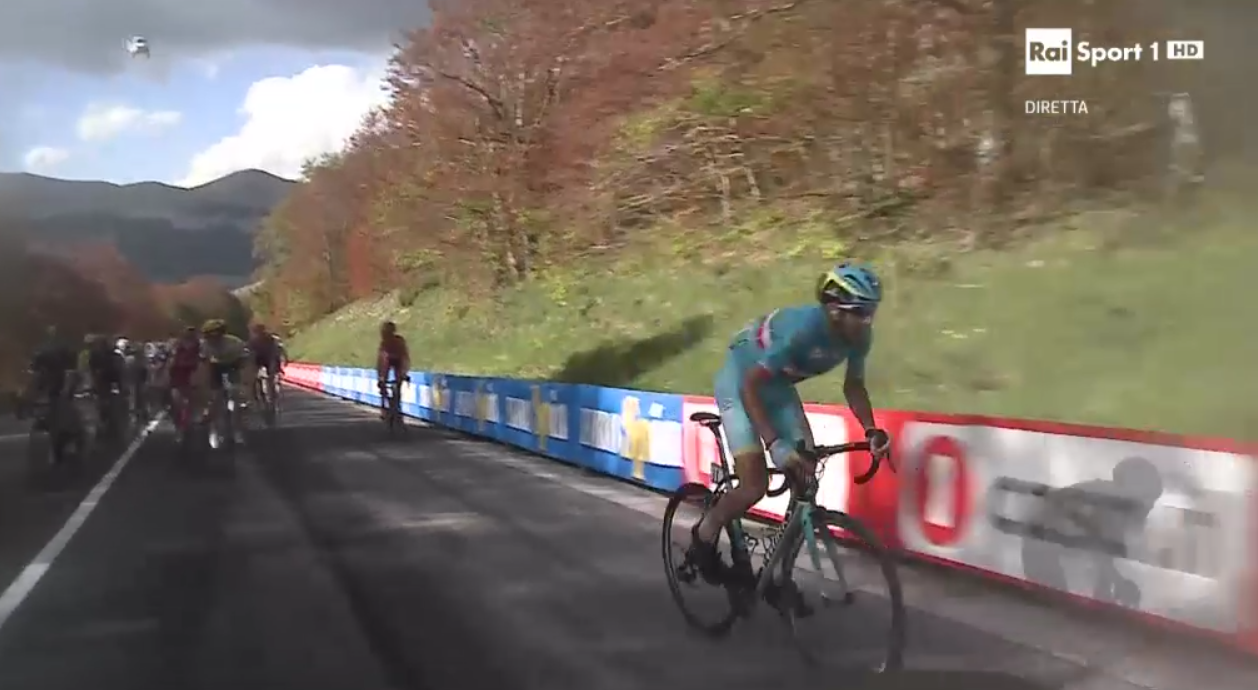
Martinello is an ex-pro who enjoyed success on the road and track in the 1990s and has an authoritative, serious voice that never betrays hesitation or doubt and as a pundit he brings plenty of insight whether the course, technical aspects like gearing or tactics. Both do their homework, a climb for them is never “a Cat 3” read from the roadbook but a real place within the landscape. Unlike the written press they don’t use nicknames too much, Nibali for example is usually Nibali only the Squalo once or twice a day. Both are reasonably balanced too, there’s enjoyment when Italian riders are active but no blind chauvinism.

They’re joined by journalists Andrea De Luca and Gianfranco Benincasa who ride on motorbikes to offer audio into what’s happening. This is the real advantage of the host broadcaster over others as it they bring insight live from the race, even spotting things before race radio. If you’re inclined you can make a killing from betting here, for example they might spot a sprinter in difficulty or punctured in the closing moments and you can find a match bet and back their rival if you’re quick enough. These roving reports are not what they were, there’s been a micro-polemic over Max Lelli getting dropped from this moto role, the ex-pro felt complained he’d been dropped without reason and what ever the cause was the presence of an ex-pro in this role meant an eye for the details, for example is someone’s ankle movement betraying signs of fatigue? It’s something the likes of Benincasa can’t spot so well. The commentators also have the quaint courtesy of saying “a voi la linea“, a sort of “over and out” when they want to hand over commentary to a colleague. Maybe in the past someone had to plug their mic in to talk or they handed over a telephone handset but today it sounds old-fashioned.
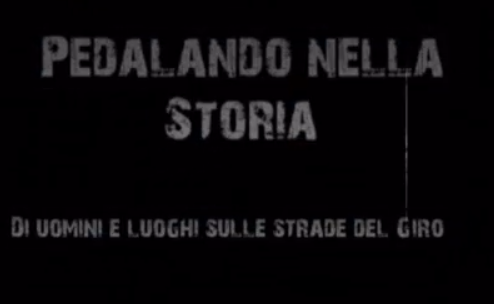
History
Talking of old-fashioned, the flat moments during a stage are covered by history inserts, a good way to revive the Giro’s heritage and satisfy the senior demographic that surely comprises a large share of the audience during a mid-week stage.
The coverage and production values are good, you’ve probably noticed most of this as it’s pumped out on the international feed too. There are a few small issues, for example the moto and heli shots seem to have different delays so you can see an event happen live in one view only for the camera to change and the event either happens again or happened five to ten seconds ago, something that’s annoying once you’ve spotted it. Also they have a high speed camera used for slow motion shots which doesn’t really add anything, they’ll film a rider reaching for their water bottle and replay the movement at one third speed. The helicopter tends to stick to the race, far more than the chateau-vision of the Tour de France. It could be the peripatetic nature but small errors can appear like wrong captions and graphics and sometimes the on-screen time gaps seem to be wrong too.
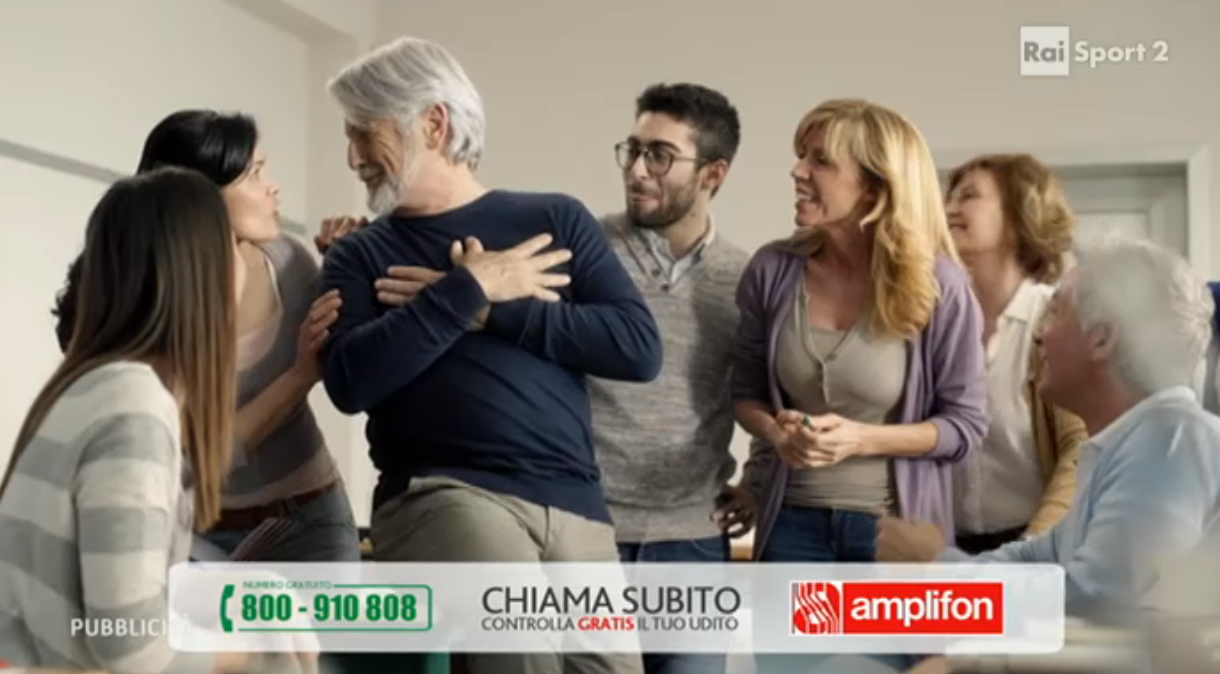
Ad breaks
There are breaks but far fewer than Eurosport crams in. These might be interludes but are still instructive, the adverts for hearing aids (pictured), denture adhesives and sub-prime consumer credit hint at an elderly and cash poor audience although, to be expected on a Thursday afternoon.
Team effort
There are more commentators. Alessandra De Stefano is there for the pre and post stage show, a serious female presence in the race to counter the pointless images of women parading in tight pink jerseys at other times. Beppe Conti is the old hand who often appears to talk about the history of the race and Stefano Garzelli is a pundit who is often called on to preview the route and then comment on the stage afterwards. Garzelli is fascinating to watch, his shaven head and plucked eyebrows make him look like an avatar from Second Life.
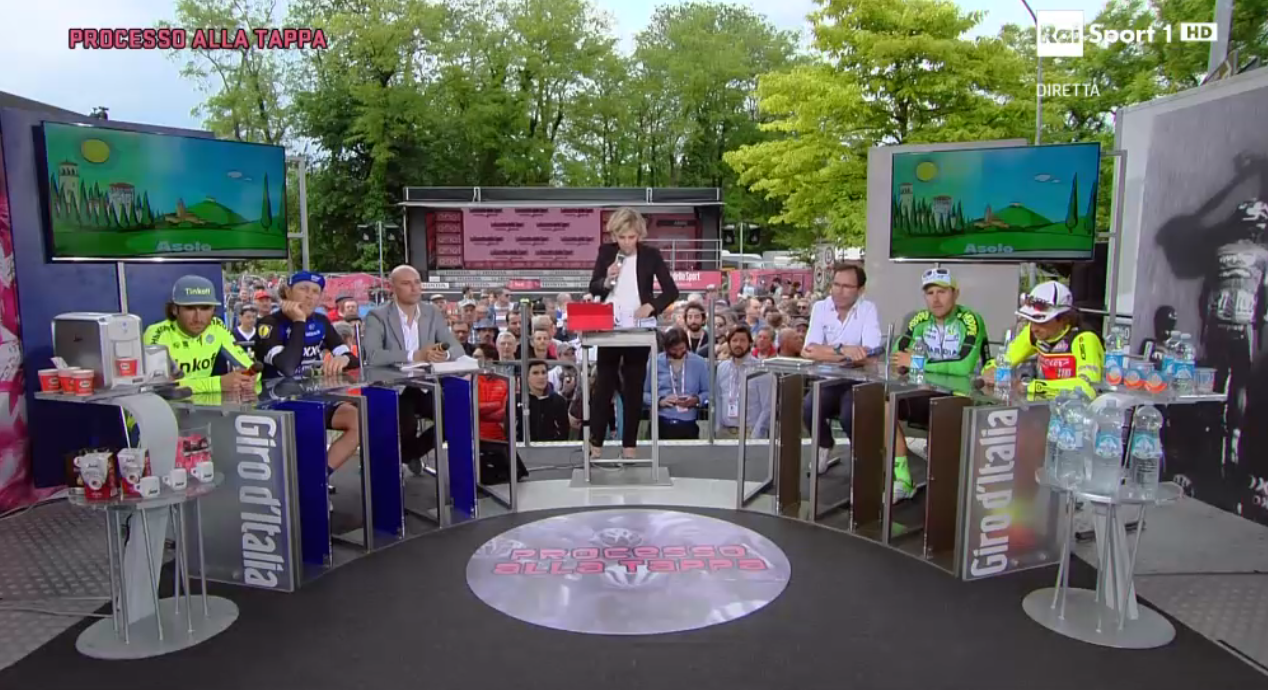
Processo
The post-stage show is Processo Alla Tappa, literally the “Trial of the Stage” broadcast live from a stage near the finish line. I can’t confirm this but it’s said it was the first ever show to be screened after a sports event to digest the action. It began in 1958 as a radio show and moved to TV in 1962. Soon after, the first ever TV slow-motion was screened on this show and apparently the autocue was invented for this broadcast. Lots of innovation but today the show is a bit stale with production barely out of the 1980s as the presenters wave big microphones and host Alessandra De Stefano regular cups her ear in order to hear the producer’s instructions. De Stefano does her enthusiastic best but the riders are often rendered monosyllabic by the racing and when one is talking the others often look bored, this isn’t a lively conversation among the athletes, or at least it isn’t until the cartoonish Michele Scarponi appears. Obviously it’s for an Italian audience so having fluent guests helps but it can feel parochial at times with a parade of Italo-Italian guests which seems to skip some of the race’s stars and characters although maybe they skip the TV and the obligation to sit in the open air when they could be heading for their hotel.
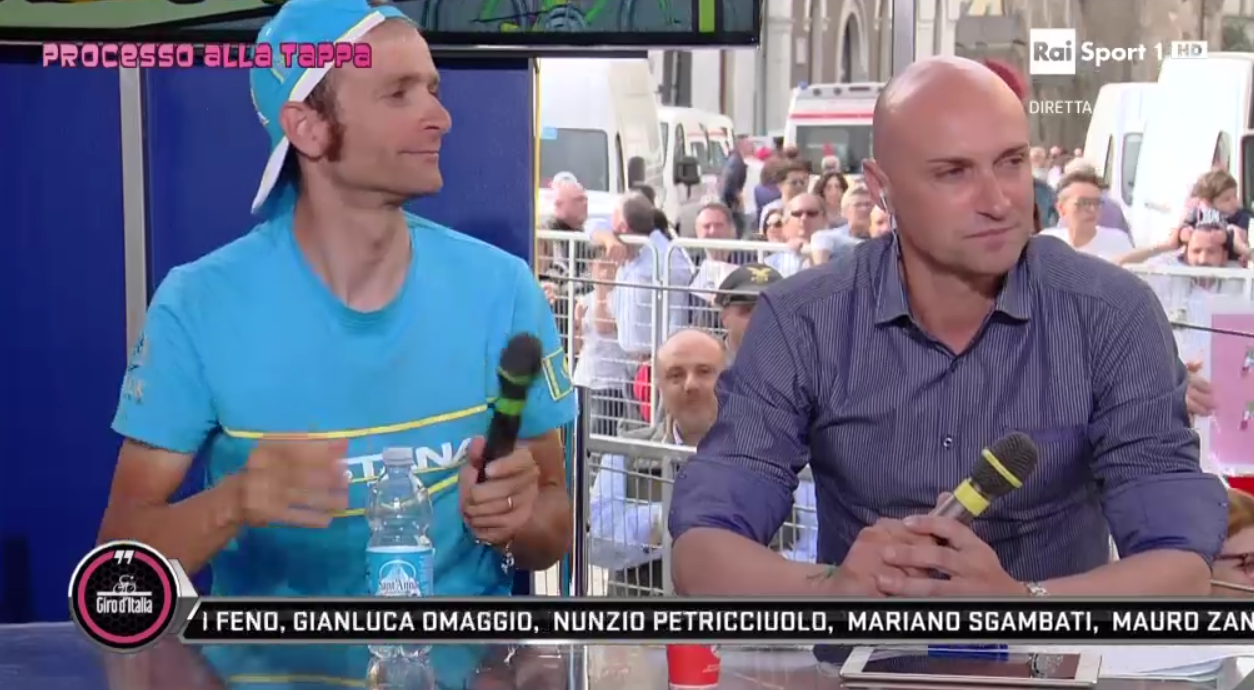
Later in the evening there’s T Giro, a 30 minute review of the day’s stage featuring highlights, analysis and interviews, a good recap if you’ve missed everything above.
Race Radio
As well as TV there’s radio. RAI means radio too and the Italian state broadcaster has live coverage from the race thanks to Massimo Ghirotto and others who report from a motorbike for Radio Uno. An ex-pro with a face for radio he’s got a rasping voice that’s loaded with expression and emotion and the radio station dips in and out of the race before a block of coverage for the finish of the stage, hear for yourself in this clip I grabbed last year. The Giro has a sponsorship deal with RDS, a rival radio station, but RAI’s coverage is superior. It’s worth remembering in case you want live coverage in audio only or perhaps via your smartphone. Most follow the Giro on TV but cycling can be a slow sport at times and radio is an excellent way to follow the race, sometimes the even the pictures are better.
Conclusion
Three hours a day on Eurosport, BeIn and especially a pirata feed probably feels like plenty especially on a day when little is happening in the race but Italians get so much more. That’s because the Giro is so much more, sometimes the race is a pretext to take Italian viewers to part of the country they don’t often see.
The actual live coverage of the racing is excellent and informative with the presenters know the race, the racers and the roads, as opposed to reading verbatim from Wikipedia. RAI manages a satisfying balance between showing off the landscape to casual viewers while covering technicalities such as crank length for proven fans and the two commentators on motorbikes are great, especially when the race enters a critical moment. Where the coverage falls down is the same everywhere, the inability to analyse a race’s key moments with analytics and modern production techniques which are deployed on other sports but rarely in cycling.

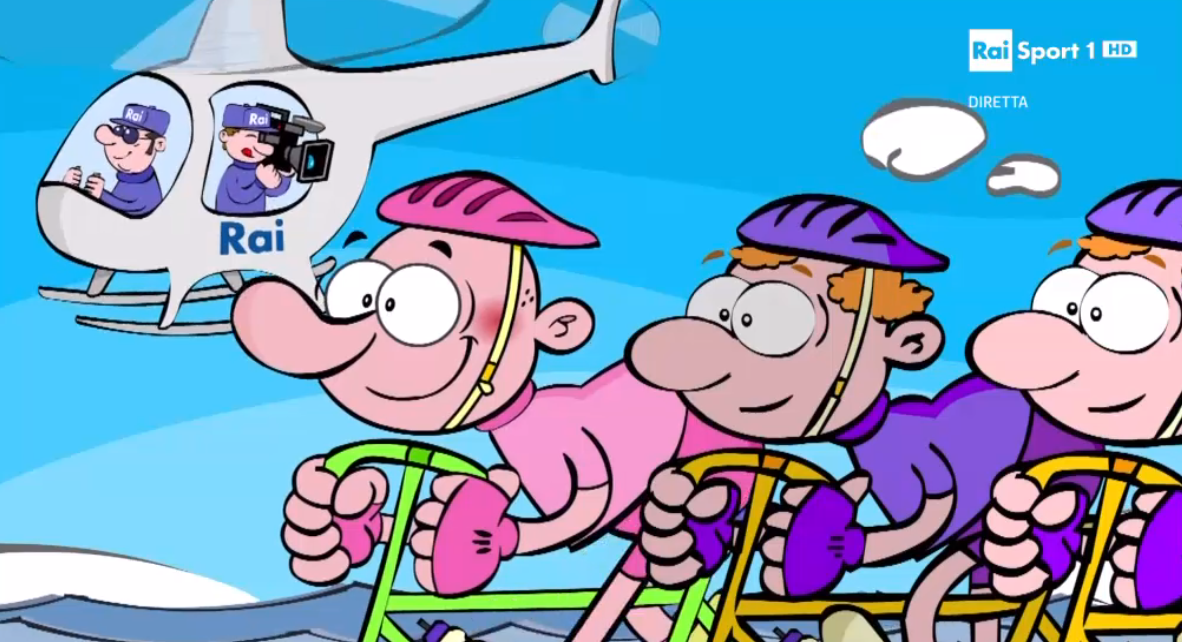
Is RAI providing the feed for Eurosport, Sporza etc?
Yes, RAI produce everything and even own the motorbikes, cameras and everything except the helicopters (by contrast France Télévisions hires contractor partners to handle a lot of the broadcast logistics on the Tour de France).
“An ex-pro with a face for radio…”
A bit unnecessary.
Sounds like they do a great job on the coverage. Must be nice to be able to watch cycle racing with consistently decent, informed commentary.
Agreed,
Very strangely, this post by Inrng has many attacks on people’s looks (Garzelli et cie).
A bit unnecessary indeed.
Garzelli’s appearance wasn’t meant to be a big deal, just an observation but it stands out more than the things he says sometimes.
So just say that his commentary can sometimes be a bit banal or uninspired. Insulting his physical appearance – even if it was just a casual, throwaway comment – is a bit tasteless.
I really don’t understand the need for the pc bs, the two people he highlighted won’t be reading this and it was amusing and borderline innocuous so get over yourself.
+1
Agreed, Ghirotto has a face for radio as you can see here
http://cycleitalia.blogspot.it/2015/05/giro-ditalia-2015-more-living-dream.html
and Garzelli’s eyebrow job creeps me out…I try to ignore it when he’s on – his commentary’s a bit bland as well – maybe when Pippo’s done with racing he’ll take over?
Still terrible taste, you can a should do better.
Really? get over it… It was a joke that I would struggle think anyone could be offended by.
Two things –
First: People taken offence – it isn’t given.
Second: If you don’t feel that you’re getting your money’s worth here, there’s alwa…. oh…
that might be the very first overall positive review of RAI shows that I’m reading in a while.
I might have stopped watching altogether RAI about 15 years ago, maybe
What I have been reading in Italian cycling forums though, is that this year they are especially unwatchable
the side shows from the morning and evening are mostly about clichès and folkloric characters “pizza, spaghetti and mandolino”
I agree that Pancani and Martinello do their job and homework nicely, it’s what comes before and after, though
“Processo alla Tappa” is just a shame of what it once was, and I’m not necessarily talking about Zavoli, but even Claudio Ferretti in more recent times seemed to bring a real journalistic vein to an emission that is, since quite a longtime now, a sad attempt to variety
plus they don’t miss a chance to stir unnecessary controversy against the “foreigner enemy”, whether is Valverde, Landa, or Griepel and Kittel (depending if they are pimping Nibali or Nizzolo)
the good: Pancani, Martinello
the very bad: Garzelli (here, it’s really bad Italian language) Fabretti, Conti (he provides “news” of transfer market like Maurizio Mosca once did for football), De Stefano (it’s been years in there, she just gets attached, I’d say emotionally, to a few cyclists and she goes over the line to protect them, and, in the end, she simply does not understand cycling despite the many years in the domain)
I agree with some of this, De Stefano has a maternal side to the riders and I didn’t know what the Processo was like in the old days, just talk that it was a very respected broadcast once upon a time.
But the “pizza, spaghetti and mandolino” is the same in other broadcasters, it is the equal if not worse during the Tour de France etc, or even look at the Tour Down Under that cuts away from the racing to tell us about the coffee and wine bars of Adelaide etc etc.
Grazie mille! All this is why it kills me to not be in Italy during La Corsa Rosa each year. Luckily for me that doesn’t happen too often. It’s like family for the entire three weeks and I miss ’em when they’re gone, warts and all. I do have to say I don’t miss Max Lelli who replaced Paolo Savoldelli, who I DO miss….but his gig with SKY’s Bike Channel probably pays a zillion times more?
Love watching the Giro on the Rai. INRNG is spot-on, the coverage is basically of a very high standard and I too appreciate the contained chauvinism of Martinelli and others when an Italian wins. Perhaps because French victories in the Tour are relatively rarer, the chief commentator on France 2/3, Thierry Adam, can be annoyingly chauvinist (to the point that the late lamented Laurent Fignon, would frequently tell him to stop speculating about French victories based on little evidence. Imagine if only Sean Kelly would do the same for Carlton Kirby when he starts gibbering about some random rider or other). The Processo all Tappa can be fun, if only because Alessandra da Stefano speaks so fast she makes most Italians sound slow, so its a very good test for me. At various points in the past the format has been a little different, with riders and commentators facing each other directly. She would then invite them to take opposing sides on some issue of controversy. Since Italians love a good polemica, this could get interesting, at least if there was really something to talk about. Quintana’s decision to ride on at the top of the Stelvio two years ago is a good example. Perhaps when the race turns upwards more seriously this year’s Processo will get a little less dull.
I was thinking of Pancani and Martinello’s balance in the light of their French equivalents Thierry Adam and Laurent Jalabert where exactly as you say Fignon would tell Adam to shut up or calm down. Adam still says things like “we’re not going to cheer on this rider just because he’s French” and then does exactly that five seconds later.
Adam is the worst cycling commentator I’ve ever see. He really doesn’t know anything about cycling, I reallywonder how he had the place.
Yes, a thousand thank yous for the richness of esoterica you provide. A perfectly sybaritic sip of my morning ciclismo espresso.
Not a RAI observation, but a general one.
I watched De Ronde on Sporza and was very surprised to see a knackered and sweaty Stijn Vandenbergh coopted straight on to their after-show live television panel after over six hours of toil, it looked like he hadn’t even had time for a shower or a change of clothing.
Was it a coincidence that he came down with saddle sores and missed Paris- Roubaix a week later?
Give the racers time to get sorted please, be it Sporza, RAI, or whoever else!
Haven’t seen the RAI TV broadcast but the website broadcast seems to have many of the features mentioned above. It is georestricted but, well, I’m not getting into that topic.
As previously stated it is an enthusiastic production with a uniquely Italian feel.
I’d suggest that perhaps the teams complained about Lelli, if he did this sort of thing: ‘is someone’s ankle movement betraying signs of fatigue?’
‘something that’s annoying once you’ve spotted it’ – Thanks for that.
Most importantly, why – uniquely, it seems – does RAI’s feed consistently break down in the rain? I’ve wondered this for years.
I am happy: A cartoon picture, donkeys and Michele Scarponi in one piece – it can’t get better than that
Apparently “Hockey Night in Canada” has been broadcast on TV since 1958. And the Derby has been reported on radio since 1923, but I’m not sure if that counts. There have been test cricket, international rugby and English football shows on radio since the late 1920s, and a live TV broadcast of Wimbledon since 1937.
I love the line: “An ex-pro with a face for radio he’s got a rasping voice that’s loaded with expression and emotion” and I am wondering if you really meant it. But I love it anyway.
Any idea on the audience rating and viewer demographics for the different segments RAI is broadcasting throughout the day? Is this something which is done by RAI out of backward-looking folklore (which for certain aspects of life like cycling might be sufficient in itself) or because there is a present demand by the Italian public for?
Many thanks for this colourful write-up, wish my Italian was better…
It seems to be a bit of both, tradition but also targetting a segment. As mentioned before on here, live broadcasts are a way for traditional terrestrial channels to win or maintain audiences in a competitive landscape (http://inrng.com/2016/04/live-tv-start-to-finish/)
As for the Giro it’s on several channels at once, Rai 3 and Rai Sport 1 and the combined audience is around 3 million. Coverage mentions satisfaction with a high share of the male audience suggesting this is their target.
Some stats in Italian on RAI’s audiences, Giro data included within http://www.ufficiostampa.rai.it/dl/UfficioStampa/Page-0a76d103-5772-4682-b9ba-d02356d38b7a.html
An interesting coverage is also the Spanish one with former tour winner Pedro Delgado.
During the vuelta he rides the toughest stages previous to the race with another ex rider and makes a TV show out of it.
French coverage with Thierry Adam and Gérard Holtz used to / is absolutely terrible. Among others, I remember a comment on the inhabitants (the sons of) the flemish town of Putte…
That “Putte” joke was Holtz when the race started in Rotterdam and rode through Belgium and required a formal apology hours later; he is being retired now.
“ATTACCO DI NIBALI”, if you’re watching you don’t need the obvious stated, but if you’re away cooking pasta per la famiglia it’s like an alarm calling you back to the TV.
I love RAI’s coverage and especially appreciate that formal Italian tone with “a voi la linea”. But on Radio Corsa Andrea De Luca drives me mad with his incessant interupting.